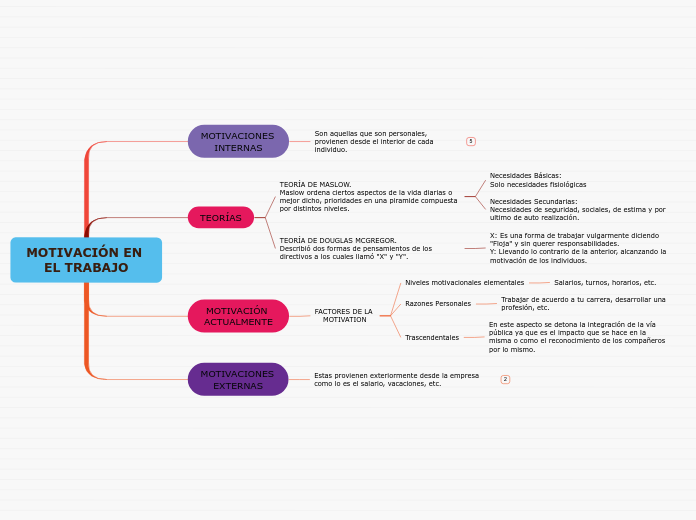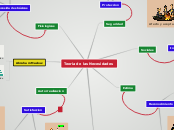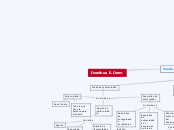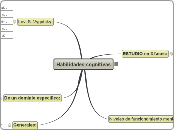MOTIVACIÓN EN EL TRABAJO
To name your story, you have to think about the overall message and what you want your audience to understand from the story. Also, make it relevant and easy to remember.
MOTIVACIONES EXTERNAS
The ending of a story is essential. We all know that if the ending is weak, what happened before loses its importance. So make it unpredictable, but fair. A resolved ending answers all the questions and ties up any loose threads from the plot.
Estas provienen exteriormente desde la empresa como lo es el salario, vacaciones, etc.
This is the closure section of the story.
See examples of possible outcomes below:
- all problems have been solved
- it's clear how each one of your characters ends up
- your main character is transformed by the challenge
Outcomes
Try answering these questions to come up with a closure:
- Have all the problems been solved?
- Is there a clear picture of what happens with each character in the story?
- Has the challenge transformed your main character?
- How do the characters feel in the end?
MOTIVACIÓN ACTUALMENTE
The middle of the story is where you add layers of complications that will lead to the end. Reveal more about the character's journey. Did their personality go through changes? How did they overcome the challenges? And as you build up the story’s central conflict, make it more personal to that character. Also, from the middle act, you have to lead into the final act.
FACTORES DE LA
MOTIVATION
Your character(s) need(s) motivation in order to solve the challenge(s).
Trascendentales
En este aspecto se detona la integración de la vía pública ya que es el impacto que se hace en la misma o como el reconocimiento de los compañeros por lo mismo.
Razones Personales
Secondary characters might also have motives that lead them to cross paths with the main character or which might trigger them to help the main character.
Trabajar de acuerdo a tu carrera, desarrollar una profesión, etc.
Niveles motivacionales elementales
Secondary characters also might have motivs beacuse of which they may cross path with main character or which might trigger them to help the main character.
Salarios, turnos, horarios, etc.
TEORÍAS
TEORÍA DE DOUGLAS MCGREGOR.
Describió dos formas de pensamientos de los directivos a los cuales llamó "X" y "Y".
X: Es una forma de trabajar vulgarmente diciendo "Floja" y sin querer responsabilidades.
Y: Llevando lo contrario de la anterior, alcanzando la motivación de los individuos.
TEORÍA DE MASLOW.
Maslow ordena ciertos aspectos de la vida diarias o mejor dicho, prioridades en una piramide compuesta por distintos niveles.
Necesidades Secundarias:
Necesidades de seguridad, sociales, de estima y por ultimo de auto realización.
Necesidades Básicas:
Solo necesidades fisiológicas
MOTIVACIONES INTERNAS
In the beginning of the story (or the exposition), you will need to introduce the setting and characters. You might also want to introduce the main conflict. This part of the story is important because it gives the reader necessary background information and maybe even a first insight into a character’s personality.
Son aquellas que son personales, provienen desde el interior de cada individuo.
Characters are essential to a good story. Usually, the protagonist(s) is/are the most affected by the plot. Introduce a character by focusing on their actions, interests, and occupation, as the physical appearance doesn't make a difference in most cases.
Character's name
Type in the name of your character.
Other
Add other qualities/attributes of the character.
Main Goal
What is your character's main goal?
fight Evilfind lovedefeat his/her enemyrule the worldmake friendstime travelmake an awesome discoveryOther
Character traits
Which traits best describe the character's personality? Choose more if necessary:
introvertedloyalkindindependentquick-thinkingadventuresomeidealisticsweet-naturedcalmrisk-takercreativewittystrictfussyweirdclumsyharshaggressivecarelessclingingcowardlycrueldeceitfulimpulsiveOther
Type of character
Choose the type of your chacter:
Protagonist (main character)Antagonist (main character's opponent)Flat (stereotypical character)Round (his/ her personality develops throughout the story)Static (doesn't evolve as a person throughout the story)Dynamic (dramatical change in personality)Confidant (the main character trusts him/ her)Foil (contrasting character who enhances the personality of another character)Other










